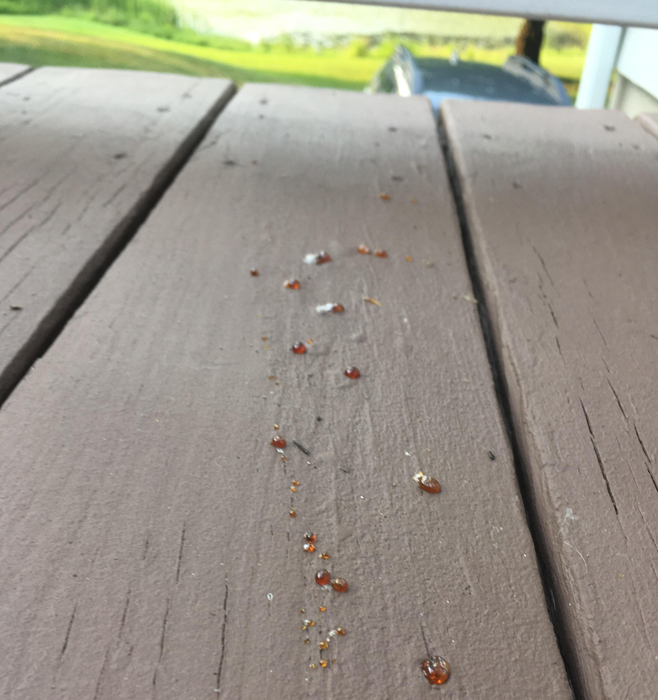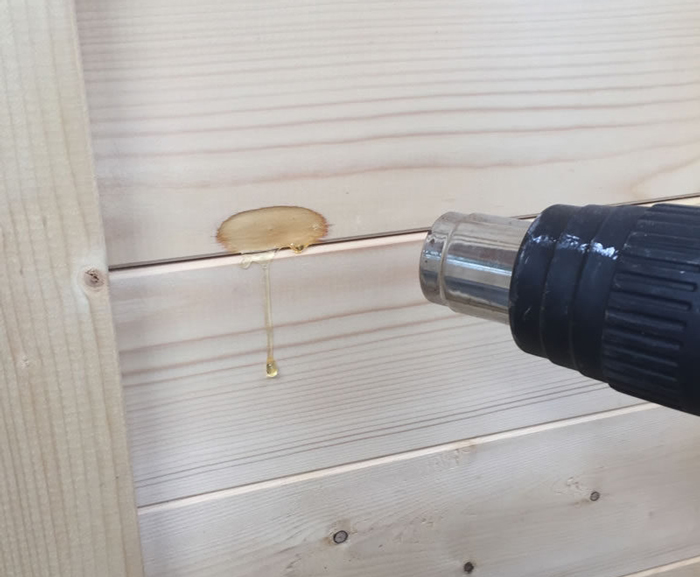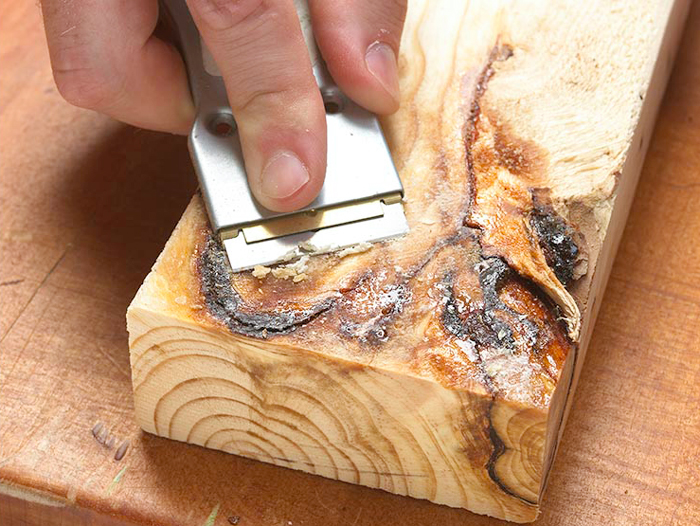A Complete Guide On How To Stop Wood From Leaking Sap
Wood sap is a natural substance that is found in different types of trees. It is a clear, thick, and sticky liquid that moves through the tree’s vascular system. Generally, a common concern people face while working with softwood is sap leakage.
So, how to stop wood from leaking sap? You can follow a simple procedure to stop wood from leaking sap.
- Firstly, scrap off any excess sap using a metal scraper.
- Use a heat gun to melt the remaining sap.
- Lastly, use a clean cloth soaked in rubbing alcohol or acetone to gently remove the melted sap.
In this article, we will discuss how you can effectively stop wood from leaking sap. Additionally, we will explore the reasons trees release sap and why it is essential to address sap leakage promptly.
How To Stop Wood From Leaking Sap?
You can prevent wood from leaking sap by following a simple technique. But before we explain the process, you need to understand that softwood leaks sap primarily for two reasons.
- The softwood may not have been properly kiln-dried.
- The sap in the softwood may not have crystallized due to insufficient temperature.

Take a look at the step-by-step instructions we have provided below to learn how to stop wood from leaking sap.
- Step 1: First, you need to take a metal scraper to scrape off the excess sap from the surface of the wood.
- Step 2: Put on your safety glasses and rubber gloves.
- Step 3: Take a heat gun and set it to 200 degrees Celsius.
- Step 4: Hold the heat gun about 3-6 inches away from the sap-covered area of the wood.
- Step 5: Start moving the heat gun around the sap-covered area in slow motion for a few minutes.
- Step 6: As you apply heat, you will notice the sap beginning to melt and become liquid. Continue to apply heat until all the sap leaks out.
- Step 7: Now, wait for 72 hours to allow the sap to crystallize.
- Step 8: Take a clean cloth or cotton and dip it into rubbing alcohol or acetone.
- Step 9: Gently rub the cloth on the sap-covered area. The alcohol will help to dissolve the sap.
- Step 10: Allow the wood to air dry completely.
- Step 11: Lastly, you can apply polyurethane or shellac to seal the wood’s surface so that it does not leak sap in the future.
For more detailed information, check out this YouTube video.
What Are The Common Types Of Wood That Leaks Sap?
Scientists from Iowa State University discovered that maple, birch, ash, white willow, linden, redbud, and mulberry trees tend to release sap. Check out the table below to learn more about the types of wood that leak sap.

| Type of Wood | Description |
|---|---|
| Maple | Releases thick, clear, or dark brown-colored sap. |
| Birch | Releases a clear, watery liquid. |
| Ash | Releases a foamy sap that has a bad odor. |
| White Willow | White willow sap is clear and watery. It has an acidic smell, and high mineral content. |
| Redbud | Releases a clear, watery fluid |
| Mulberry | Mulberry sap is clear and watery, with a mildly sweet taste. |
| Pine | Pine sap is sticky and smells like pine trees. |
| Cedar | Releases a sticky, reddish-brown liquid |
What Are The Common Causes Of Wood Leaking Sap?
Below, we have listed some common reasons why you might notice sap leaking from wood.

Age Of The Tree
As trees get older, it is common for them to develop cracks and crevices in their bark. Because of this, they may release sap more frequently.
A study has shown that older trees can release between 0.70 to 14.40 dm3 of sap in a day. However, younger trees release between 1.40 to 10.90 dm3 volume of sap daily.
The Tree Sustains Damage
According to a researcher, trees produce sap when they are infected by pathogens or sustain physical damage. When a tree gets damaged because of changes in the weather, animals, or diseases, it makes sap to seal the wound.
Moreover, researchers from the University of Florida say that wood sap acts as a natural shield for the tree when it gets injured. The sap comes out and covers the wound to stop pathogens and insects from entering the tree.
Wood Infected By Insects
If you see tiny holes on the surface of the wood, it could mean that insects have infested the tree. Insects like emerald ash borer, bark beetles, and bronze birch borer tend to dig into tree branches to lay eggs or eat the wood. When this happens, the tree might release sap in an attempt to get rid of these insects.
Wood Infected By Fungi
Sometimes, you might see certain parts of a tree that appear discolored or decayed. This is a sign of a fungal infection.
According to a research paper, some types of fungi that cause heart rot only grow in trees and cannot survive in cut wood. When this occurs, trees release a nutritious substance that quickly dries and stops the spread of the infection.
Changes In The Season
The amount of sap flowing in trees can change throughout the year. Trees tend to grow actively during spring and early summer. Therefore, during that time, sap flow is typically higher. This can cause more sap to seep out from wounds or the bark of the tree.
What Will Happen If You Don’t Take Proper Steps To Stop Wood From Leaking Sap?

Below, we have listed several major consequences you might have to face. It will happen if you do not promptly take the necessary steps to stop wood from leaking sap.
- The wood will become more prone to fungal infection.
- The wood will become discolored.
- The wood may rot faster due to increased moisture.
- It may emit an unpleasant odor as it decays.
- Fungi and mold may grow on the sap-covered area on the wood.
- The durability of the wood will decrease.
- You won’t be able to paint the surface of the wood that is covered with sap.
- Cleaning sap off wood is tough and time-consuming.
FAQs
If you want more details on how to stop wood from leaking sap, read the frequently asked questions.
Q: What should I do if I notice sap leaking from my wooden furniture?
If you see sap coming out of your wooden furniture, softly wipe it away with a cloth. Then, put a wood sealant on it to stop more sap from leaking.
Q: Can I stop sap leakage with a wood conditioner?
Usually, wood conditioners are meant to help stains or finishes soak in better. They might not directly stop sap from leaking. It is better to use sealants to stop wood from leaking sap.
Q: Can cutting off dead tree branches help stop trees from leaking sap?
Yes, pruning can help stop the trees from leaking sap. When you remove the dead or affected tree branches, it lowers the chance of sap leaking from those spots.
Final Words
In conclusion, wood leaks sap as a natural defense mechanism. When the tree sustains a wound or gets damaged, it releases sap to heal the wounded area and keep off harmful pathogens.
You can stop wood from leaking sap by scraping off excess sap with a metal scraper. Then, use a heat gun to melt the sap and use rubbing alcohol or acetone to completely remove the sap from the wood’s surface.
Additionally, to prevent further sap leakage, you can apply polyurethane or shellac on the affected area.




